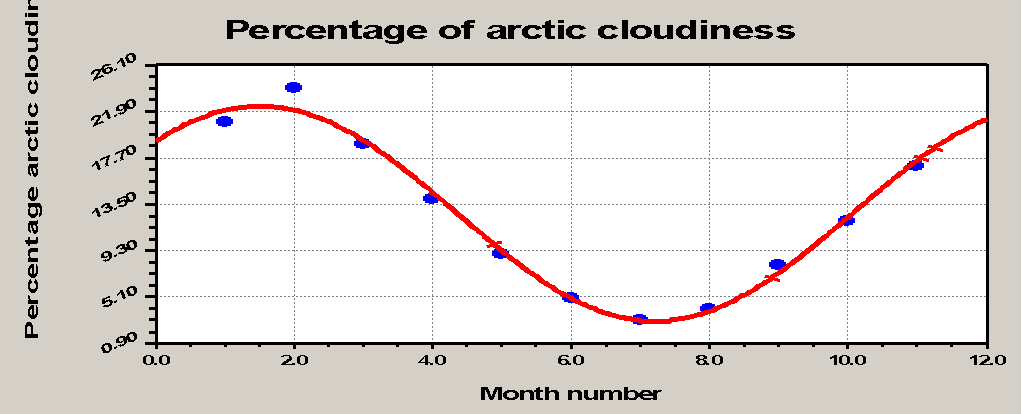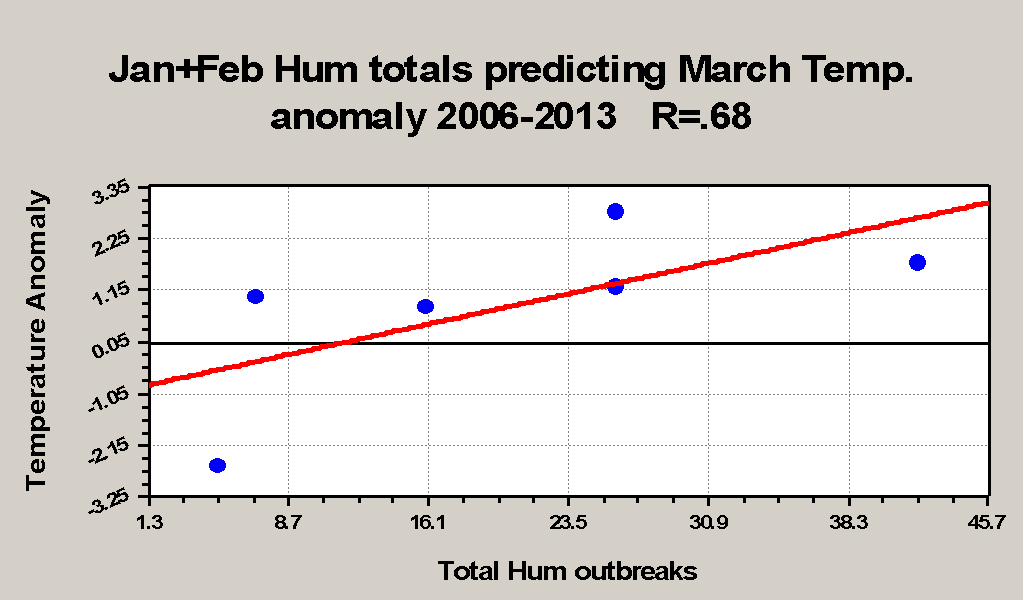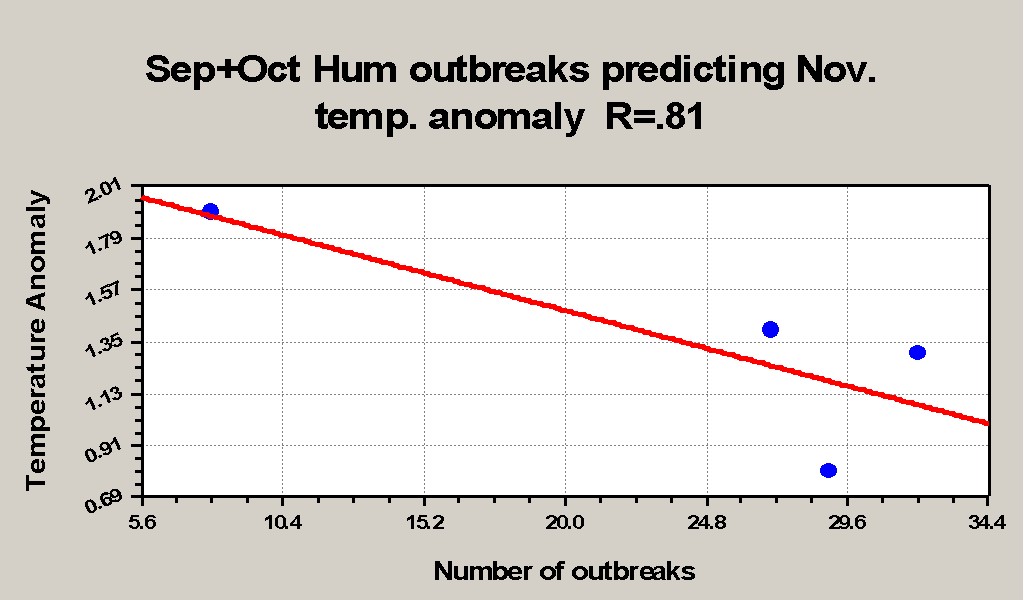The Hum as a medium range weather forecaster in the guise of a forward predictor of local geographic temperature by Dr Chris Barnes, Bangor Scientific and Educational Consultants email doctor.barnes@univ.bangor.ac.uk
Abstract
The phenomenon known as the Hum is described by way of reference to its history and present explanations. World-wide renewable energy systems would now appear to have best geo-spatial correlation with the Hum. Other than the earth itself and near space environment, such systems are possibly unique in being able to be providers of multiple signals of infrasonic, acoustic and electromagnetic nature all bearing potentially coherent or quasi-coherent phase relationships with each other. Propagation of such signals can also be via multiple channels including the earth (a seismic and ground conductivity channel) and the air a channel capable of propagating infrasound, acoustic sound and electromagnetic waves. There is considerable evidence that power line harmonic radiation disturbs the space weather environment of the earth. Together with the effects of high power radio transmitters this disturbance to earth’s natural geomagnetism and seismicity coupled with more local components is in all probability the Hum. Any type of radiation which modulates natural geomagnetic processes or vice versa must inevitably be linked to electron precipitation events in the ionosphere. These events have recently been linked by processes such as the global electric current and AGWS to control of heights of arctic layer cloud and hence facets of the radiation budget of the planet. Put simply, the height of the clouds determines their temperature, which then determines how much energy they radiate. The total bimonthly Hum outbreak events as subjectively perceived by two Hum sensitive subjects in North Wales appear to be a better predictor of UK Wales average temperature (anomaly) for a month ahead i.e. providing a medium range prediction than simply averaging preceding temperatures but only in the winter and early autumn months. The percentage of arctic cloudiness has a negative slope with time after February when enhanced numbers of Hum events causes a temperature increase in Wales. Between September and November arctic cloudiness has a positive slope whereas increased rate of Hum events causes a temperature decrease. Anthropogenic influence of power systems, including wind turbines and powerful radio transmitters on our climate system has neither been considered previously nor even accepted as a possibility by mainstream meteorologists and/or climatologists. Recently Britain has seen more extremes of weather which is simply put down to climate change allegedly due to anthropogenic greenhouse gas emissions. Within Brittan’s extremes of climate seems to be a recent trend towards hotter springs and colder winters. The effect of power systems on the arctic environment as indicated by its monitor ‘the Hum’ is not presently at odds with these longer term observations. Besides the effects of volcanism and aircraft, electron precipitation changes the global electric circuit and hence will also alter atmospheric aerosol which is the ‘other side of the coin’ in climate control. In this present work the number of Hum outbreaks has been assessed quantitatively simply by the experience of afflicted individuals. In a sense this is ground breaking work and is state of the art as evidence by the work of Arrowsmith et al (2010) who discuss the Seismoacoustic wave-field in terms of a 'New Paradigm in Studying Geophysical Phenomena'. However, although these authors recognise numerous seismic and infrasonic sources, they do not mention wind farms the most major contributor to the Hum, see Barnes http://www.drchrisbarnes.co.uk/OAM.htm. Since an almost continuous new infra sound signal is observed in many parts of the world which looks like an approximate 1 Hz ( and harmonics) comb spectrum ( see Pepyne and Klaiber Prc. 92nd Meeting A.M.S) and can be heard up to 60km from wind farms, the possibility to instrument this for weather and climate research is, in the opinion of the present author, now rife.
Introduction
The Hum is a geo-sporadic, often nocturnal, partially acoustic menace which may be perceived by some individuals by a combination of senses in addition to normal audition [1]. Thus in such ways it can sometimes manifest as an infrasonic phenomenon, a magneto-acoustic phenomenon or a gravito-acoustic phenomenon. It can cause general annoyance and sleep disturbance and is even reputed to have caused a few suicides [2]. Some people who perceive the Hum have very acute hearing especially at the infrasound end of the acoustic spectrum. It is quite possible there may be a genetic factor in this and in Hum perception in general. Other ideas are that increased LFN and increased pulsed radio emissions somehow sensitise the ears/body to the Hum frequencies [1].
It is reckoned that between 2-11% of individuals hear/perceive the Hum depending on age group [1-3]. The peak age for hearing appears to be in middle age but the author is personally aware of individuals as young as 28 and as old as 82 who perceive the Hum. Those afflicted describe hearing a noise rather like a distant irregular idling engine or a large bee trapped in a bottle. Being a subjective phenomenon based on human experience descriptions are naturally bound to vary somewhat. Musically inclined ‘hummers’ people who hear or perceive the Hum tend to tone match it as between 30-80 Hz yet having quasi periodic modulations in both amplitude and frequency. Of late there are more descriptions of the Hum sounding more ‘impulsive’. This ties in with the observation that geo-spatially modern Hums seem to tie in with the distribution of renewable energy systems [4].
There was a Hum like phenomenon reported in Victorian times known as the ‘Hummadruz’ but this was reportedly like the continuous sound a swarm of bees at dusk and sustainably different from the contemporary Hum and probably was due to sound form newly established steam powered factories.
The first sporadic reports of the contemporary Hum began in the 1950’s. However, it did not become well known in the UK until the 1970’s and in the USA until the 1990’s. Because the so called Taos Hum in the USA could not be audio recorded, the Hum took on an almost supernatural guise. There were also those who stated that the Hum was most likely due to Motorways and High Pressure Gas Mains. The former Soviet Union had these but in the 1990’s had no renewable energy. Since there was then no Hum in the then USSR or China there were those who dismissed the gas mains idea and instead reached the conclusion that its time and position in space most likely seemed to correspond with operation of western military communication aircraft known as TCAMO, see for example Deming [3] which, incidentally, newer versions of which still fly today. However, since the Hum has now become a virtually world-wide phenomenon the time is perhaps nigh to seek alternative explanations. It is undeniable from mapping meta-analysis that geo-spatially modern Hums seem to tie in with the distribution of renewable energy systems, see Barnes [4-7].
Other than the earth itself and near space environment, such power systems are possibly unique in being able to be providers of multiple signals of infrasonic, acoustic and electromagnetic nature all bearing potentially coherent or quasi-coherent phase relationships with each other. Propagation of such signals can also be via multiple channels including the earth (a seismic and ground conductivity channel) and the air a channel capable of propagating infrasound, acoustic sound and electromagnetic waves. Naturally, the main acousto-radiating elements of such systems are their generators, particularly wind and hydro-turbines. Additionally, there are power transformers and in terms of electromagnetic energy, transmission lines themselves. Whereas for ideally balanced transmission lines, operating at their fundamental 50Hz or 60Hz frequency, the many TW of power flow on earth would only result in a few watts leakage into the ground or into space, renewable energy causes imbalance and the resultant radiation of considerable orders of magnitude extra harmonic radiation as do non-linear loads such as steel mills and cyclo-converters. Furthermore, infrasonic and acoustic radiation from power systems possibly accounts for between .1 and 1% of their total output which nevertheless equates to many GW of sound equivalent energy spread world-wide.
There is considerable evidence that power line harmonic radiation disturbs the space weather environment of the earth. Together with the effects of high power radio transmitters this disturbance to earth’s natural geomagnetism and seismicity coupled with more local components is in all probability the Hum. Any type of radiation which modulates natural geomagnetic processes or vice versa must inevitably be linked to electron precipitation events in the ionosphere. These events have recently been linked by processes such as the global electric current and AGWS to control of heights of arctic layer cloud and hence facets of the radiation budget of the planet, see The Hum and Monthly Temperature Anomaly in Wales, Barnes (2013) [8], revised February 2015 . Put simply, the height of the clouds determines their temperature, which then determines how much energy they radiate. High-level clouds are cold and radiate little heat into space; instead, they reflect heat radiation back towards Earth’s surface, warming the atmosphere and magnifying the greenhouse effect. Low-level clouds, more compact and warmer, emit more heat radiation into space than back towards Earth. They act as a parasol, reflecting sunlight and thus cooling Earth’s surface. A cloud’s altitude, therefore, determines its effect on the climate.
The present author has recently shown a predictable relationship between the number of days with Hum and the local UK (Wales) temperature anomaly for the most recent six years of study [8].
This present study poses the question can the Hum be used predicatively as a medium range weather forecaster and further is it a better predictor than just preceding months’ temperature trends. This is based firstly on the notion that UK met office are interested in tele-connection between the Arctic and UK, see ECMWF-WWRP/THORPEX Polar Prediction Workshop 24-27 June 2013 European Centre for Medium-Range Weather Forecasts Reading, UK [9] and, secondly on the notion that most anthropogenic electromagnetic space weather interactions will be expected to take place in the auroral oval, see for example but not exclusively, Lessard et al. [10].
Experimental and Data Sets
The present author and his wife are both ‘hummers’ (people who perceive the Hum, see [3]) and have records of their Hum perception experiences going back to 2006. Hum was judged on a subjective intensity scale from 0= no hum to 10 = intolerable. All events with intensity >2 were recorded as total monthly events. Based on the monthly relationship for Arctic cloudiness, see figure 1 below, it was decided to see if various bimonthly Hum event totals could predict the next month’s mean temperature anomaly better than simple averaging of the preceding bimonthly temperature totals.

Figure 1
Results and Discussion

Figure 2
The linear regression coefficient above was found to be .68 compared with a linear regression coefficient of .61 by simply using average January and February temperature anomalies to predict the March anomaly. With an effective p value of circa 0.06 the method is just about statistically significant.
Similar prediction methods did not produce significant correlations in the spring and summer months.
The cumulative number of September and October Hum outbreaks correlated very well with November temperatures with a negative slope and a correlation regression value of .81, see Figure 3. Its modulus being significantly greater than that of .69 for bimonthly temperature anomaly alone. The p value is .05 which is just statistically significant.

Figure 3
Conclusions and Discussion
The total bimonthly Hum outbreak events as subjectively perceived by two Hum sensitive subjects in North Wales appear to be a better predictor of UK Wales average temperature (anomaly) for a month ahead i.e. providing a medium range prediction than simply averaging preceding temperatures but only in the winter and early autumn months. The percentage of arctic cloudiness has a negative slope with time after February when enhanced numbers of Hum events causes a temperature increase in Wales. Between September and November arctic cloudiness has a positive slope whereas increased rate of Hum events causes a temperature decrease.
Anthropogenic influence of power systems, including wind
turbines and powerful radio transmitters on our climate system has neither been
considered previously nor even accepted as a possibility by mainstream
meteorologists and/or climatologists. Recently Britain has seen more extremes
of weather which is simply put down to climate change allegedly due to
anthropogenic greenhouse gas emissions. Within Brittan’s extremes of climate
seems to be a recent trend towards hotter springs and colder winters. The
effect of power systems on the arctic environment as indicated by its monitor
‘the Hum’ is not presently at odds with these longer term observations.
Besides the effects of volcanism and aircraft, electron precipitation changes the global electric circuit and hence will also alter atmospheric aerosol which is the ‘other side of the coin’ in climate control.
Because of a weaker solar cycle and a new planetary beat hypothesis, the Northern Hemisphere in particular may be affected by a new Maunder like minimum circa 2030-2050 which may dramatically offset some warming present regardless of cause, see for example but not limited to Solheim (2013) [11].
I firmly believe that if, for whatever reason, we ever
need to geo-engineer, based on the evidence the Hum has provided,
electromagnetic methods offer substantial hope.
In this present work the number of Hum outbreaks has been
assessed quantitatively simply by the experience of some afflicted individuals.
In a sense this is ground breaking work and is state of the art as evidence by
the work of Arrowsmith et al (2010) [12] who discuss the Seismoacoustic wave-field in terms of a 'New Paradigm in
Studying Geophysical Phenomena'. However, although these authors recognise
numerous seismic and infrasonic sources, they do not mention wind farms the
most major contributor to the Hum, see Barnes http://www.drchrisbarnes.co.uk/OAM.htm
[7]. Since an almost continuous new
infra sound signal is observed in many parts of the world which looks like an
approximate 1 Hz ( and harmonics) comb spectrum ( see Pepyne and Klaiber Prc. 92nd Meeting A.M.S)[13] and can be heard up to 60km from wind farms, the possibility
to instrument this for weather and climate research is, in my opinion now rife.
References
1. http://www.drchrisbarnes.co.uk/lfnhum.htm
2. http://en.wikipedia.org/wiki/The_Hum
3. http://www.scientificexploration.org/journal/jse_18_4_deming.pdf
4. http://www.drchrisbarnes.co.uk/TheHumQuestionsandAnswers.htm
5. http://www.drchrisbarnes.co.uk/lfnhum.htm
6. The Hum now also a Chinese Phenomenon by Dr
Chris Barnes Bangor Scientific and Educational Consultants http://www.drchrisbarnes.co.uk/Chinahum.htm
7. Wind farms with OAM, the major source,
amongst renewables, of infrasound which leads to the contemporary world LFN
phenomenon known as the Hum? By Dr
Chris Barnes, Bangor Scientific and Educational Consultants, e-mail
doctor.barnes@yahoo.co.uk. First
published on Internet 06/05/2014, http://www.drchrisbarnes.co.uk/OAM.htm
8. http://www.drchrisbarnes.co.uk/WXHUM.HTML
10.Polar Report Final Geo-space http://www.sienageospace.dreamhosters.com/wp-content/uploads/2013/06/polar_interior_final.pdf
11.Signals from the planets, via the Sun to
the Earth http://www.pattern-recogn-phys.net/1/177/2013/prp-1-177-2013.pdf
12.http://onlinelibrary.wiley.com/doi/10.1029/2010RG000335/full
13.92nd American Meteorological Society Annual
Meeting (January 22-26, 2012) https://ams.confex.com/ams/92Annual/webprogram/meeting.html